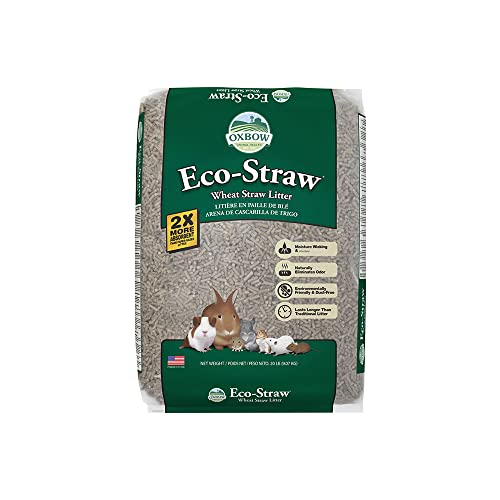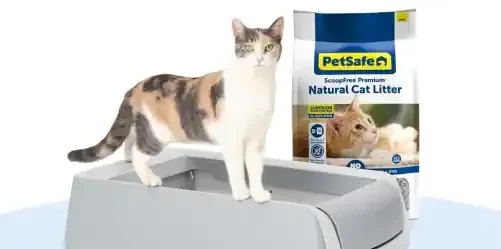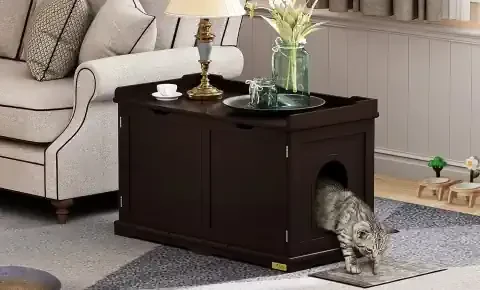Understanding Cat Litter Box Behavior and Preferences
Caring for a feline companion involves more than just providing food and shelter; it's about understanding their unique behaviors and preferences, especially when it comes to their litter box habits. This section delves into the intricacies of feline behavior and how it relates to litter box maintenance.
The Importance of a Clean Litter Box
A clean litter box is not just a matter of aesthetics; it's essential for your cat's physical and mental well-being. Cats are naturally fastidious animals, and a dirty litter box can cause them significant stress. Imagine if you had to use a restroom that hadn't been flushed or cleaned in days – it's not a pleasant thought, is it? The same goes for your cat.
A dirty litter box can lead to a variety of problems, including:
Litter Box Aversion: Cats may refuse to use a dirty litter box, opting instead to find other, less desirable places to relieve themselves.
Urinary Tract Infections: A dirty litter box can harbor bacteria that may lead to urinary tract infections or other health issues.
Behavioral Problems: Stress caused by a dirty litter box can manifest in other behavioral issues, such as aggression or excessive grooming.
To maintain a clean litter box, it's important to scoop it daily and perform a thorough cleaning at least once a week. By keeping the litter box clean, you're not just ensuring your cat's comfort – you're also fostering a healthier and happier relationship with your feline friend.
Types of Cat Litter Boxes
When it comes to cat litter boxes, one size doesn't fit all. There are various types of litter boxes available, each with its own set of pros and cons. Understanding the different types can help you choose the best option for your cat.
Open vs. Closed Litter Boxes: Open litter boxes are the most common type and are preferred by some cats because they offer easy access. Closed litter boxes, also known as hooded or covered litter boxes, provide privacy and help contain odors but may feel confining to some cats.
Automatic Cat Litter Boxes: Automatic litter boxes use sensors to detect when your cat has used the litter box and automatically scoop the waste into a separate compartment. While convenient, they may not be suitable for all cats, especially those who are sensitive to noise or motion.
Top-Entry Litter Boxes: Top-entry litter boxes have a lid on top, requiring cats to enter from above. These litter boxes help prevent litter tracking and provide privacy, but some cats may find them intimidating or difficult to use.
Choosing the right litter box is crucial for your cat's comfort and well-being. Consider your cat's size, age, and preferences when selecting a litter box, and don't be afraid to experiment with different types until you find the perfect fit.
Choosing the Right Location for the Litter Box
The location of the litter box can significantly impact your cat's willingness to use it. Cats are creatures of habit and prefer quiet, low-traffic areas for their litter boxes. Here are some factors to consider when choosing a location:
Accessibility: The litter box should be easily accessible to your cat at all times. Avoid placing it in areas that are difficult for your cat to reach, such as high shelves or tight corners.
Privacy: Cats prefer privacy when using the litter box, so choose a location that offers some degree of seclusion. Avoid placing the litter box in busy areas of the house, such as the kitchen or living room, where there's a lot of foot traffic.
Avoiding High-Traffic Areas: Cats are sensitive to their surroundings and may feel vulnerable when using the litter box. Avoid placing it in areas where there's a lot of noise or activity, such as near the washing machine or next to the front door.
By choosing the right location for the litter box, you can help ensure your cat feels comfortable and secure when using it. This, in turn, can help prevent litter box aversion and encourage regular litter box habits.
Selecting the Cat Right Litter
Choosing the right litter is essential for maintaining a clean and inviting litter box environment for your cat. With various options available on the market, it's important to consider your cat's preferences and your own cleaning routine when selecting the perfect litter.
Clumping vs. Non-Clumping Cat Litter
One of the primary considerations when choosing litter is whether to opt for clumping or non-clumping varieties. Here's what you need to know about each type:
Clumping Litter: Clumping litter forms solid clumps when it comes into contact with moisture, making it easy to scoop and remove waste. This type of litter is popular among cat owners for its convenience and effectiveness in controlling odors.
Non-Clumping Litter: Non-clumping litter absorbs liquid but does not form clumps, requiring more frequent full litter changes. While it may be less convenient than clumping litter, it can be a suitable option for cats with certain sensitivities or for those who prefer a different texture.
When choosing between clumping and non-clumping litter, consider your cat's preferences, as well as your own cleaning habits. Some cats may have a preference for one type over the other, so it may require some experimentation to find the best fit.
Natural vs. Synthetic Cat Litter
Another consideration when choosing litter is whether to opt for natural or synthetic varieties. Here's a breakdown of the differences between the two:
Natural Litter: Natural litter is made from biodegradable materials such as corn, wheat, or paper. It is environmentally friendly and typically safer for cats, as it does not contain harmful chemicals or additives.
Synthetic Litter: Synthetic litter is usually made from clay-based or silica gel materials and may contain added fragrances or chemicals for odor control. While synthetic litter may offer superior odor control, some cats may be sensitive to the added fragrances or chemicals.
When choosing between natural and synthetic litter, consider your cat's sensitivities and any environmental concerns you may have. Natural litter is a more eco-friendly option, but synthetic litter may offer better odor control – ultimately, the choice comes down to what works best for you and your cat.
Scented vs. Unscented Cat Litter
Litter is available in both scented and unscented varieties, each with its own set of pros and cons:
Scented Litter: Scented litter contains added fragrances or perfumes to mask odors and keep the litter box smelling fresh. While scented litter may be more pleasant for humans, some cats may find the added fragrance overpowering or unpleasant.
Unscented Litter: Unscented litter does not contain any added fragrances or perfumes, making it a safer option for cats with sensitive noses or allergies. Unscented litter allows your cat's natural scent to prevail and may be more appealing to finicky felines.
When choosing between scented and unscented litter, consider your cat's preferences and sensitivities. Some cats may have strong reactions to scented litter, while others may not be bothered by it at all. Experiment with both types to see which one your cat prefers.
Considering Your Cat's Preferences
Above all, it's essential to consider your cat's preferences when selecting litter. Some cats may have specific preferences when it comes to litter texture, scent, or type, so it may require some trial and error to find the perfect fit. Pay attention to your cat's behavior and reactions to different types of litter, and be willing to make adjustments as needed to ensure they are comfortable using the litter box. By choosing the right litter, you can create a comfortable and inviting litter box environment that your cat will love.
Establishing a Cat Litter Box Cleaning Routine
Maintaining a regular cleaning routine for your cat's litter box is essential for both your cat's health and your own sanity. By staying on top of litter box maintenance, you can ensure a clean and odor-free environment for your cat to do their business. Here's how to establish an effective cleaning routine:
Frequency of Cleaning
Regular scooping and cleaning of the litter box are essential to prevent odor buildup and maintain a hygienic environment for your cat. Here's a breakdown of how often you should clean the litter box:
Daily Maintenance: Scoop the litter box at least once a day to remove waste and clumps. This prevents the buildup of odor and keeps the litter box clean and inviting for your cat.
Weekly Deep Cleaning: In addition to daily scooping, perform a thorough cleaning of the litter box at least once a week. Empty the litter box completely, scrub it with mild soap and water, and rinse it thoroughly before refilling it with fresh litter.
By establishing a regular cleaning routine, you can prevent odor buildup and ensure a clean and comfortable environment for your cat.
Proper Cleaning Techniques
When cleaning the litter box, it's essential to use the right techniques to ensure effective cleaning and prevent the spread of bacteria. Here are some tips for proper cleaning:
Scooping and Disposal: Use a scoop to remove waste and clumps from the litter box, disposing of them in a sealed bag or trash bin. Avoid flushing cat waste down the toilet, as it can contribute to environmental pollution.
Wiping Down Surfaces: After scooping, wipe down the interior surfaces of the litter box with mild soap and water to remove any lingering residue or bacteria. Rinse the litter box thoroughly and allow it to dry completely before refilling it with fresh litter.
Changing Litter Regularly: In addition to regular scooping, it's important to change the litter completely on a regular basis. Empty the litter box entirely and clean it thoroughly before refilling it with fresh litter. This helps prevent odor buildup and keeps the litter box clean and hygienic for your cat.
By following these proper cleaning techniques, you can ensure a clean and inviting litter box environment for your cat and minimize the risk of bacterial contamination.
Managing Odors Effectively
Effective odor control is essential for maintaining a pleasant living environment for both you and your cat. While some odor is inevitable when it comes to cat litter boxes, there are several strategies you can employ to manage and minimize odors effectively.
Odor Control Products
Various odor control products are available on the market designed specifically for cat litter boxes. These products work to neutralize odors and keep the litter box smelling fresh. Here are some common types of odor control products:
Deodorizers: Litter box deodorizers are powders or sprays designed to be sprinkled or sprayed into the litter box to neutralize odors. They often contain enzymes or other odor-fighting ingredients that break down odor-causing bacteria.
Air Purifiers: Air purifiers are devices that help remove airborne particles and odors from the air, including those emitted from the litter box. Place an air purifier near the litter box to help keep the surrounding air clean and fresh.
Litter Box Filters: Some litter boxes come equipped with built-in filters that help trap and neutralize odors before they escape into the air. These filters should be replaced regularly to maintain their effectiveness.
When using odor control products, be mindful of your cat's sensitivities and preferences. Some cats may be sensitive to strong fragrances or chemicals, so opt for natural or unscented products whenever possible.
Natural Odor Neutralizers
In addition to commercial odor control products, there are several natural remedies that can help neutralize odors in the litter box. Here are a few examples:
Baking Soda: Sprinkling a thin layer of baking soda at the bottom of the litter box can help absorb odors and keep the litter box smelling fresh. Baking soda is a natural odor neutralizer that is safe for cats and effective at reducing litter box odors.
Activated Charcoal: Activated charcoal is another natural odor absorber that can help neutralize odors in the litter box. Place a few pieces of activated charcoal in a breathable pouch and hang it near the litter box to help keep odors at bay.
Ventilation Strategies: Improving ventilation in the area where the litter box is located can help reduce odors by allowing fresh air to circulate. Open windows or use fans to help dissipate odors and keep the air smelling fresh.
By incorporating natural odor neutralizers into your litter box maintenance routine, you can effectively manage odors without exposing your cat to potentially harmful chemicals or fragrances.
Ventilation Strategies
Proper ventilation is key to preventing odors from becoming trapped in your home. Here are some strategies to improve ventilation around the litter box area:
Open Windows: Whenever possible, open windows near the litter box to allow fresh air to circulate and help dissipate odors.
Use Fans: Use fans to help improve airflow in the room where the litter box is located. Position fans strategically to direct odors away from living areas and towards ventilation sources.
Air Purifiers: Consider using an air purifier near the litter box to help remove airborne particles and odors from the air. Look for an air purifier with a HEPA filter, which is effective at trapping odor-causing particles.
By implementing these ventilation strategies, you can help keep the air in your home smelling fresh and clean, even with a cat litter box in the vicinity.
Preventing Litter Tracking
Litter tracking – the pesky phenomenon of finding bits of litter scattered throughout your home – is a common issue for many cat owners. While it may seem unavoidable, there are several strategies you can employ to minimize litter tracking and keep your home clean.
Using Cat Litter Box Mats
Litter mats are designed to trap litter particles as your cat exits the litter box, preventing them from being tracked throughout your home. Here's how to effectively use litter mats:
Choose the Right Mat: Look for litter mats with a textured surface that effectively captures litter particles stuck to your cat's paws. Mats with deep grooves or ridges are particularly effective at trapping litter.
Place Mats Strategically: Position litter mats directly outside of the litter box to catch litter as your cat exits. You can also place additional mats near high-traffic areas where your cat frequents to capture any stray litter particles.
Clean Mats Regularly: To maintain effectiveness, clean litter mats regularly by shaking them out or vacuuming them to remove trapped litter. Some mats are also machine washable for easy cleaning.
By using litter mats strategically, you can significantly reduce litter tracking and keep your floors clean and litter-free.
Trim Your Cat's Nails Regularly
Long nails can easily pick up and track litter particles throughout your home. By keeping your cat's nails trimmed, you can minimize litter tracking and keep your floors cleaner. Here's how to trim your cat's nails safely and effectively:
Use Pet-Safe Nail Clippers: Use nail clippers specifically designed for cats to trim their nails. Avoid using human nail clippers, as they may cause discomfort or injury to your cat.
Handle Your Cat Gently: Approach nail trimming with patience and care, and handle your cat gently to keep them calm and relaxed during the process.
Trim Nails Regularly: Trim your cat's nails every few weeks to keep them at an appropriate length. Be sure to only trim the sharp tip of the nail, avoiding the quick, which contains blood vessels and nerves.
Regular nail trimming not only helps prevent litter tracking but also reduces the risk of your cat accidentally scratching furniture or injuring themselves.
Consider Alternative Litter Types
Some types of litter are less prone to tracking than others. Consider experimenting with alternative litter types to minimize litter tracking in your home. Here are a few options to consider:
Heavier Granules: Litter with heavier granules is less likely to stick to your cat's paws and be tracked throughout your home. Look for litter made from materials such as clay or recycled paper, which tend to have larger, heavier granules.
Larger Particles: Litter with larger particles is also less likely to be tracked by your cat. Consider trying litter made from materials such as wood pellets or crystal gel, which have larger, more uniform particles.
Low-Dust Formula: Opt for litter with a low-dust formula to minimize airborne particles that can contribute to litter tracking. Look for litter labeled as "low-dust" or "dust-free" for cleaner, less dusty litter.
By experimenting with alternative litter types, you can find one that minimizes litter tracking and keeps your home cleaner and more comfortable for both you and your cat.
Addressing Behavioral Issues
Behavioral issues related to the litter box can be frustrating for both you and your cat. Understanding the underlying causes of these issues and addressing them effectively is crucial for maintaining a harmonious relationship with your feline companion. Here's how to tackle common behavioral issues related to the litter box:
Litter Box Aversion
Litter box aversion occurs when a cat refuses to use the litter box consistently. This behavior can be caused by a variety of factors, including:
Dirty Litter Box: Cats are fastidious animals and may avoid using a dirty litter box. Ensure the litter box is clean and scooped regularly to encourage your cat to use it.
Litter Box Location: Cats prefer quiet, low-traffic areas for their litter boxes. If the litter box is located in a busy or noisy area, your cat may be reluctant to use it. Consider moving the litter box to a more secluded location.
Litter Preference: Some cats may have preferences when it comes to litter texture, scent, or type. Experiment with different types of litter to find one that your cat likes.
Addressing litter box aversion requires patience and persistence. Keep the litter box clean and accessible, and work with your cat to find a solution that works for both of you.
Multiple Cat Household Dynamics
In multi-cat households, litter box issues can arise due to competition and territorial behavior. Here's how to address litter box problems in a multi-cat household:
Provide Multiple Litter Boxes: Ensure there are enough litter boxes available for all of your cats, plus one extra. Having multiple litter boxes reduces competition and territorial disputes.
Spread Out Litter Boxes: Place litter boxes in different areas of your home to provide cats with options and prevent conflicts over resources.
Monitor Interactions: Keep an eye on your cats' interactions around the litter boxes and intervene if necessary to prevent conflicts.
By providing adequate resources and monitoring interactions between your cats, you can minimize litter box issues in a multi-cat household and maintain a peaceful coexistence.
Stress and Anxiety
Stress and anxiety can also contribute to litter box problems in cats. Here are some common causes of stress and anxiety in cats:
Changes in Routine: Cats thrive on routine, and changes to their environment or daily schedule can cause stress. Minimize changes whenever possible and provide a predictable routine for your cat.
Environmental Stressors: Loud noises, unfamiliar people or animals, or changes in the home environment can all trigger stress in cats. Identify and eliminate stressors to help reduce your cat's anxiety.
Health Issues: Underlying health problems can also cause stress and anxiety in cats. If your cat is exhibiting signs of stress, such as changes in litter box behavior, consult your veterinarian to rule out any medical issues.
Addressing stress and anxiety in cats requires a holistic approach that addresses both environmental and emotional factors. Provide a safe and secure environment for your cat, and seek veterinary guidance if necessary to address underlying health issues.
Tips forTraining Kittens To The Litter Box
Training kittens to use the litter box is an essential part of their development and can help prevent future litter box issues. By providing positive reinforcement and establishing a consistent routine, you can set your kitten up for litter box success. Here are some tips for training kittens:
Introducing the Litter Box
Introduce your kitten to the litter box as early as possible to establish good habits from the start. Here's how to introduce the litter box to your kitten:
Placement: Place the litter box in a quiet, accessible location away from your kitten's food and water bowls. Show your kitten where the litter box is located and encourage them to explore it.
Encouragement: Place your kitten in the litter box after meals or naps to encourage them to use it. Gently scratch the litter with your fingers to simulate digging behavior, which may prompt your kitten to use the litter box.
Positive Reinforcement: Praise and reward your kitten when they use the litter box successfully. Offer treats or verbal praise to reinforce good behavior and encourage them to continue using the litter box.
By providing positive reinforcement and encouragement, you can help your kitten associate the litter box with a positive experience and establish good litter box habits from the start.
Positive Reinforcement
Positive reinforcement is a powerful tool for training kittens to use the litter box. Here's how to use positive reinforcement effectively:
Consistency: Be consistent in praising and rewarding your kitten whenever they use the litter box correctly. Offer immediate praise or treats to reinforce the desired behavior.
Use Rewards: Offer rewards such as treats, toys, or verbal praise to reinforce good litter box behavior. Make the rewards immediate and consistent to strengthen the association between using the litter box and receiving a reward.
Avoid Punishment: Avoid scolding or punishing your kitten for accidents or mistakes. Negative reinforcement can create fear or anxiety around the litter box and may lead to future litter box issues.
By using positive reinforcement consistently, you can help your kitten develop positive associations with the litter box and establish good litter box habits for life.
Consistency and Patience
Consistency and patience are key when training kittens to use the litter box. Here's how to maintain consistency and patience throughout the training process:
Establish a Routine: Stick to a consistent feeding and litter box schedule to help your kitten develop predictable bathroom habits. Feed your kitten at the same times each day and provide opportunities for them to use the litter box after meals or naps.
Be Patient: Understand that accidents may happen during the training process, and be patient with your kitten as they learn. Avoid becoming frustrated or angry, as this can undermine the training process and create stress for your kitten.
Provide Support: Offer support and guidance to your kitten as they learn to use the litter box. Monitor their progress and provide assistance or encouragement as needed to help them succeed.
By maintaining consistency and patience, you can help your kitten develop good litter box habits and set them up for success in the future.
Monitoring Your Cat's Health Through the Litter Box
The litter box can provide valuable insights into your cat's health, making it essential to monitor their litter box behavior regularly. By paying attention to changes in your cat's bathroom habits, you can detect potential health issues early and seek prompt veterinary care. Here's how to monitor your cat's health through the litter box:
Signs of Potential Health Issues
Keep an eye out for the following signs that may indicate underlying health problems in your cat:
Changes in Urination: Pay attention to changes in the frequency, volume, or color of your cat's urine. Increased or decreased urination, blood in the urine, or straining to urinate may indicate urinary tract issues.
Changes in Defecation: Monitor your cat's bowel movements for changes in frequency, consistency, or color. Diarrhea, constipation, or bloody stools may be signs of gastrointestinal issues.
Changes in Litter Box Behavior: Note any changes in your cat's litter box behavior, such as avoiding the litter box altogether, spending more time than usual in the litter box, or vocalizing while using the litter box.
These changes in litter box behavior may indicate underlying health problems and should be addressed promptly by a veterinarian.
Regular Vet Check-Ups
Schedule regular veterinary check-ups for your cat to monitor their overall health and well-being. During these check-ups, your veterinarian will perform a thorough physical examination and may recommend additional tests or screenings to assess your cat's health.
Be sure to mention any changes in your cat's litter box behavior or bathroom habits to your veterinarian during these check-ups. These observations can provide valuable clues about your cat's health and help your veterinarian make an accurate diagnosis.
Changes in Litter Box Behavior
Keep track of any changes in your cat's litter box behavior and address them promptly. Here are some common changes to watch out for:
Avoiding the Litter Box: If your cat suddenly starts avoiding the litter box or urinating/defecating outside of the box, it may indicate a medical issue or behavioral problem that requires attention.
Straining to Urinate: Straining to urinate or frequent trips to the litter box may be signs of urinary tract issues, such as a blockage or infection.
Excessive Litter Box Use: If your cat is spending more time than usual in the litter box or making frequent trips to the box without producing much urine or feces, it may indicate a health problem that requires investigation.
By monitoring your cat's litter box behavior regularly and seeking veterinary care for any changes or abnormalities, you can help ensure early detection and treatment of potential health issues.
Conclusion: Maintaining a Clean Home and Happy Cat
Mastering cat litter box maintenance is essential for creating a clean and comfortable environment for both you and your feline companion. By understanding your cat's behavior and preferences, selecting the right litter, and establishing a consistent cleaning routine, you can prevent litter box issues and keep your home odor-free. Additionally, addressing behavioral issues, training kittens, and monitoring your cat's health through the litter box are crucial steps in maintaining your cat's overall well-being.
Remember, maintaining a clean litter box isn't just about aesthetics – it's about promoting your cat's physical and mental health. By providing a clean and inviting litter box environment, you can ensure your cat feels safe, secure, and happy in their home. So, take the time to implement these tips and strategies, and enjoy a harmonious relationship with your feline friend for years to come.







